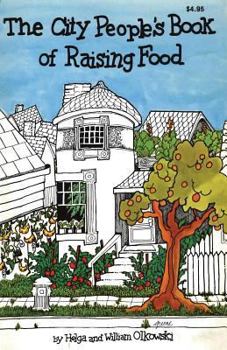City People's Book of Raising Food
Select Format
Select Condition 
Book Overview
A least toxic approach to raising food in urban gardens based on the authors' experiences in Berkeley, CA. Authors are both entomologists noted for organic least toxic pest control who specialized in gardening in small spaces with deep mulches made by composting and transplanting and methods for extending the season. Written with beginners in mind who have little time for gardening with many personal anecdotes. Illustrated with line drawings by Kathy Green. We cover the basics: soil structure and soil improvement, odorless composting, insect control, selecting vegetable varieties for small areas, pest free food scrap storage for composting, intensive interplanting, beekeeping, rooftop meat and greens, setting up community gardens, raising rabbits and chickens in congested places. Written almost 40 years ago the methods are still current and useful. Its a classic in the gardening literature by people who developed the methods.
Format:Paperback
Language:English
ISBN:1467919918
ISBN13:9781467919913
Release Date:January 2014
Publisher:Createspace Independent Publishing Platform
Length:242 Pages
Weight:0.60 lbs.
Dimensions:0.5" x 5.1" x 7.8"
Customer Reviews
1 rating
Live Healthier and Longer with your own Garden
Published by Thriftbooks.com User , 18 years ago
This extraordinary book is the best I have ever seen on home gardens. Its authors grew all their own vegetables and meat from a tiny California plot. Application of the sound ecological principles in this book could increase the carrying capacity of the Earth by many times, and we would not have to worry about overpopulation for a while. Even Health Food stores may add irritating chemicals to Organically Grown food, as I learned from an extremely chemically-sensitive friend who could not eat such produce. Also, food loses nutrients between farm and store, no matter how it is grown. So you simply cannot buy as high-quality food in any store at any price as you can grow yourself. The authors had great success getting their city of Berkeley to adopt ecologically sound pest control. This is one of the most essential chapers in the book. 3 R's and an S of Pest Control R-Residues. Most of us worry about this one. R-Resurgence. Pesticides build up to higher levels in predators than prey, leading to the pest Resurgence to higher levels than before. This R is of concern with "Organic" methods like onion spray and not only from artificial poisons. S-Secondary pests. Pests that had been present in very minor numbers may explode to major problems with the removal of predators. R-Resistance. Most of us understand that pests' high reproductive rates mean that pests resistant to chemical controls soon become the entire population. These ecological understandings are essential to anyone who wishes to make a truly positive contribution to the well-being of the natural world and to the human ecosystems that depend on it.





